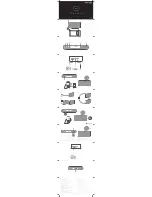
EVOLVE Portable Column Loudspeaker
Troubleshooting | en
37
Electro-Voice
User manual
2021-04 | v04 | F.01U.393.750
9
Troubleshooting
Problem
Possible cause
Action
1.
No sound
Amplifier
Verify all the electronics are on, the signal
routing is correct, the source is active; the
volume is turned up, no channels are muted,
etc.
Correct/repair/replace as necessary. If there is
still no sound, the problem may be wiring.
Wiring
Verify you have connected the correct cables to
the amplifier. Play something at a low level
through the amplifier. Connect a test
loudspeaker in parallel with the malfunctioning
line. If the sound level is gone or is very weak,
the line has a short in it (possibly a severe
scrape, pinch, or a missed connection). Using
the test loudspeaker, move down the line and
test each connection/junction until you find the
problem and correct it. Observe proper
polarity.
2.
Intermittent
output such as
crackling or
distortion
Faulty connection
Check all connections at amplifier and
loudspeakers to ensure they are all clean and
tight. If the problem persists, check the wiring.
See problem 1.
3.
Constant noise
such as
buzzing hissing
or humming
Defective source or
other electronic
device
If noise is present, but no program material is
playing, evaluate each component as necessary
to isolate the problem. Most likely there is a
break in the signal path.
Poor system
grounding or ground
loop
Check and correct the system grounding, as
required.
4.
No sound
produced with
microphone
connected to
INPUTS 1-4
Microphone requires
phantom power.
Ensure the microphone is connected to INPUTS
1-4. Phantom power is not available on INPUT
5/6.
Input channel is
muted or LEVEL is too
low.
Select the channel and verify the channel is not
muted. If it is not muted, slowly increase the
channel LEVEL until sound is produced.
5.
Sound is
distorted front
LED is OFF,
LCD screen
LIMIT is ON
Excessive input level
Reduce the input level or loudspeaker level to
prevent limit.
Incorrect gain
structure or source
input (mixing console/
preamp) is overdriven
Verify level controls of the source are properly
structured by using the VU meter indicator on
the LCD screen. If the VU meter bar is solid or
the system indicates CLIP or LIMIT, the input or
source level is too high.








































